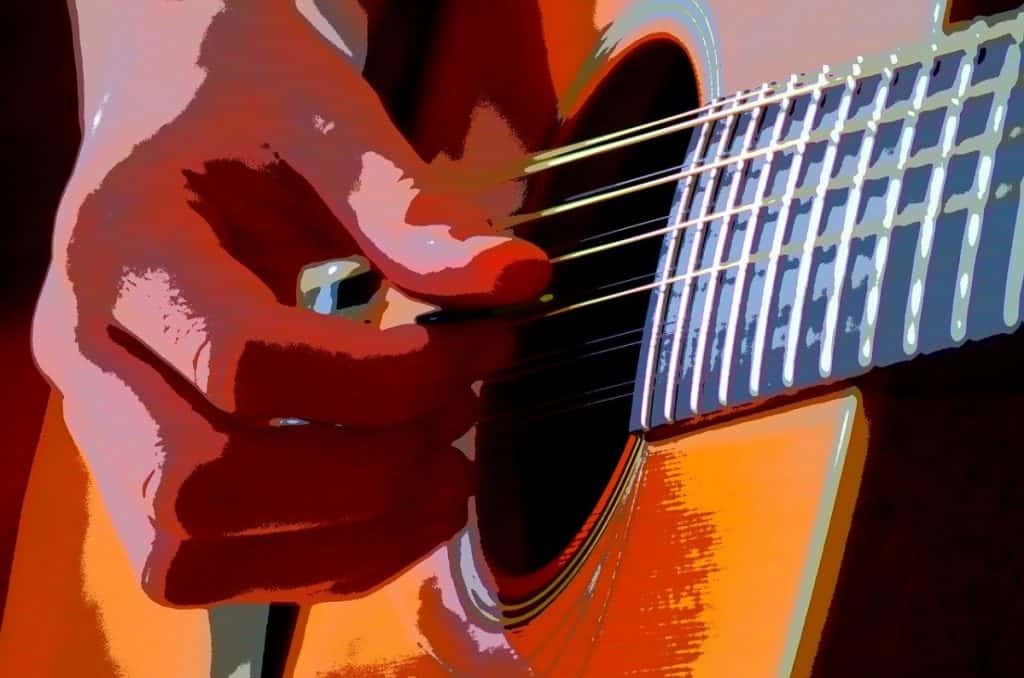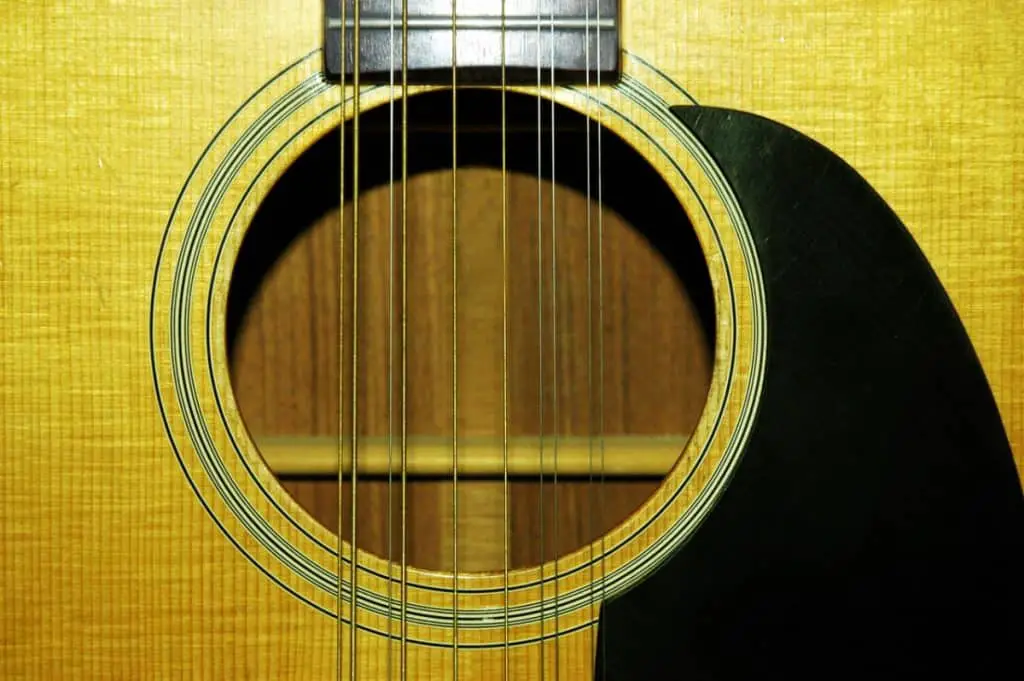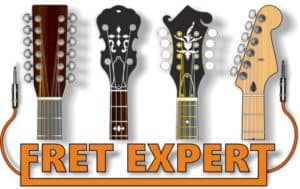I’m often asked if beginners should start with a 12-string guitar – and if it’s even possible to do so – or whether it would be more “sensible” to start with a 6-string. The answer, as usual, isn’t clear cut, and it depends on the beginner!
Here’s a complete guide of the pros and cons of starting with a 12-string instead of a 6-string. The learning curve is harder, but it can be more rewarding. I also cover how to read (and write your own) tabs, to help you learn faster.
When you’ve decided that you’re going to buy one, check out this complete guide on what to look for when buying a 12-String Guitar, too.
Covered in this Article:
Should Beginners Choose a 6 String or 12 String Guitar?
If you’ve never played the guitar before, the most sensible place to start is with a 6-string classical guitar (also known as a Spanish guitar).
The main reason for this is that the nylon or composite strings are a lot gentler on the fingers, in contrast to their less forgiving steel-stringed acoustic and electric counterparts.
They are also an ideal introduction for children of all ages as they’re graded into four basic sizes to accommodate different shapes and sizes of players.
But that’s not why you’re reading this article, right? To give you an idea, here’s where you’ll be placing yourself on a difficulty scale by starting with a 12-string:
Degree of difficulty for new players
1. Classical Guitar
2. Electric Guitar
3. Acoustic Guitar
4. 12-String Electric Guitar
5. 12-String Acoustic Guitar
The upshot of this is that you’re going to need more ambition and dedication to master a 12-string right off the bat. But it can be done!
If you want to begin on a 12-string acoustic guitar, it’s not impossible, just a slightly more difficult journey lies ahead. You should also carry out a bit of self-analysis with regard to how you’re likely to react if things get a little tricky.
If you’re the dogged, determined type, you could probably learn on a plank of wood with strings attached and you’d still achieve your goal.
If, on the other hand, you’re easily put off when things aren’t as easy you’d imagined they might be, it’s probably sensible to start off on something with a shorter learning curve.
If you’re determined (and good for you if you are), then your next decision will be which type of 12-string guitar to go for, if you’re a beginner: Acoustic or Electric.
Tip: If you’re about to buy a 12 string, you’ll definitely want to read my guide to the best 12 string guitars for beginners (covering all price ranges) and what to look for before buying your first 12 string guitar, too.
The Pros and Cons of a 12-String Acoustic Guitar for Beginners
Here are things to think about when looking at starting with an acoustic 12-string guitar:
Pros:
- The 12-string produces a beautiful full-bodied ringing tone.
- Effective as a solo instrument without needing other musicians to fill out the sound.
- Very effective while using a fingerstyle technique
Cons:
- The hardest of all the guitar types to play. Quite punishing on un-callused fingers.
- Not the subtlest of sounds and not everybody’s cup of tea.
- Not ideal for playing lead solos.
- Definitely one to avoid if you’re buying for a young child.
- It can take a while to tune or re-string.

The Pros and Cons of a 12-String Electric Guitar for Beginners
Here are considerations if you want to go for a 12-String electric guitar, as a beginner:
Pros:
- If you love that jangly sound made famous by artists such as Roger McGuinn of The Byrds, look no further!
- It produces the chorus-type effect without the need for an effects pedal!
- Sounds very effective using a fingerpicking technique.
Cons:
- A bit harder to play than a regular 6-string electric guitar.
- Not usually the place for a beginner to start.
- Very prone to fret buzz if you aren’t accustomed to the extra pressure needed to play the 12-string cleanly. Also, some models have a slim neck, making accurate fretting an issue with the double-width strings.
- Not many cheap entry-level instruments are available.
- Not really suitable for children.
- Like the acoustic version, it can take a while to tune or re-string.

12 String Guitar Tabs and Chords for Beginners
The internet is awash with music for the guitar, more so than for any other instrument. You can name any artist from the last hundred years and there will more than likely be a tab (short for tablature) or chord chart for that particular song.
When it comes to chords and tabs it’s irrelevant whether your instrument has 6 or 12 strings, as it’s always treated as a 6-string instrument. The 12-string version simply has paired or double strings representing each open note.
Therefore any tabs and chords written for the 6-string also apply to the 12-string guitar, too.
Simple Tab Examples (for 12-string or 6 string Guitar)
The following simple tabs of ‘Twinkle Twinkle Little Star’ give examples of how a basic tab can be written.
The image below shows a simple 1 string tab without four beats to the bar. The bar divisions are set up to mirror natural breaks in the music. This type of tab is suitable for children:

The tab below is similar to the first example, but is written to complement regular notation, with each bar division containing four beats to the bar (i.e. four crotchets in bar 1, two crotchets and one minim in bar 2 etc.):

Next, it gets a little more complicated in the example below. The same notes are spread over three strings, but it still retains the simplicity of natural breaks in the music, without mirroring notation:

Finally, this next example is again spread over three strings and is written to mirror standard musical notation (i.e. 4 beats in the bar):

Some frequently asked beginner questions on these illustrated 12 String Guitar Tabs are below:
Why would you spread your tab melody over more than one string?
The reason tabs are generally spread over several strings is to make fingering a lot easier. With example 3 and 4 of ‘Twinkle Twinkle Little Star’, your fingers don’t ever stray beyond a total of four frets. This makes your playing a lot more fluid as well.
Why are some tabs written on just one or two strings?
A simple tab of this nature, as featured in the first two examples above, is a lot easier for children to read, even though it is spread over eight frets and an open string position.
The disadvantage is it makes smooth playing a little more challenging because of the exaggerated jumps from fret 7 to fret 2 for example. It is much less confusing for children or absolute beginners, though.
How do I write my own tabs for my 12-string guitar?
The examples I’ve given were compiled in a very simple text editor using Courier New, a monospaced font suitable for lining everything up correctly.
Obviously, there are far more sophisticated tab editors than this with dedicated music features, but this is simply to show a low-tech method will work just as well.
Your other alternative is to buy a blank tabs workbook and write out your tabs in the traditional way with a pen or pencil. Here’s one I recommend, on Amazon. It’s cheap, cheerful and has almost 150 pages for tab creation.
If you’re creating your own tab lines, remember you will need six evenly spaced parallel lines. Also, your lowest string (the one nearest to your chin) will always occupy the bottom line of your tab.
A final option for drawing your own tab and staff lines is a nice little gadget from Momiji Music called the ‘LineSlider’. It’s a Japanese product, but rather than importing it you can get it on Amazon.
What if I’m writing chords or want to specify playing more than one string/note at a time?
Your tab fret numbers should line up underneath each other. For instance, take the chords of E, Am, C, D and D7 written as a tab.
The illustration below demonstrates how the separate parts of the chord are lined up underneath each other. What it doesn’t give you are which fingers you need to use to form the chord, but most positions become apparent when you go to form the chord shape:

Is there a difference between 6-string and 12-string guitar tabs?
No difference at all. A standard tab will treat all instruments as if they had six strings, unless it’s a tab for a different type of fretted instrument such as the ukulele, mandolin or banjo.
What are the Best 12 String Guitar Songs for Beginners?
This is a tricky question to answer as any ‘regular’ guitar song will work just as well when its played on the 12-string guitar.
However, here are some popular examples of songs associated with the 12-string guitar:
- The Boxer – Simon & Garfunkel
- Eight Miles High – The Byrds
- Free Fallin’ – Tom Petty & The Heartbreakers
- A Horse with No Name – America
- A Hard Day’s Night – The Beatles
- Give a Little Bit – Supertramp
- My My, Hey Hey (Out of the Blue) – Neil Young
- Hotel California – The Eagles
- Lola – The Kinks
- More Than a Feeling – Boston
- Mr. Tambourine Man – The Byrds
- Queen – Crazy Little Thing Called LoveSpace Oddity – David Bowie
- Stairway to Heaven – Led Zeppelin
- Take it Easy – The Eagles
- Ticket to Ride – The Beatles
- Wanted Dead or Alive – Bon Jovi
- Wild Horses – The Rolling Stones
- The Weight – The Band
- Wish You Were Here – Pink Floyd
- Wonderwall – Oasis
If you’ve decided to pick up a 12-string guitar, then I hope your journey will be just as fun and interesting as mine has been. You should definitely read my pick of the best 12 string guitars for beginners, and also what to look for when buying a 12 string guitar.
Remember, it’s not really about being the very best or playing to jam-packed stadiums around the world, it’s about reaching your own goals in your own time, in your own way and enjoying every minute of it!
If you don’t progress beyond three chords, but still have a blast doing it, that’s great!
